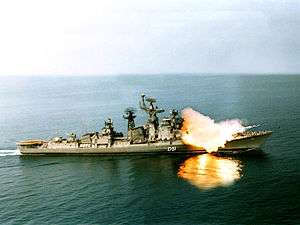INS Rajput (D51)
INS Rajput is a guided-missile destroyer and the lead ship of the Rajput class of the Indian Navy. She was commissioned on 4 May 1980. Commodore (later Vice Admiral) Gulab Mohanlal Hiranandani was her first commanding officer.
.jpg) INS Rajput underway | |
| History | |
|---|---|
| Name: | INS Rajput |
| Namesake: | Rajput |
| Owner: | Indian Navy |
| Operator: | Indian Navy |
| Builder: | 61 Kommunara Shipbuilding Plant |
| Commissioned: | 4 May 1980 |
| Identification: | Pennant number: D51 |
| Status: | in active service |
| Badge: |
_crest.jpg) Seal of INS Rajput |
| General characteristics | |
| Class and type: | Rajput-class destroyer |
| Displacement: |
|
| Length: | 189 m (620 ft) |
| Beam: | 15.8 m (52 ft) |
| Draught: | 5 m (16 ft) |
| Propulsion: | 4 x gas turbine engines; 2 shafts, 72,000 hp (54,000 kW) |
| Speed: | 35 knots (65 km/h) |
| Range: |
|
| Complement: | 320 (including 35 officers) |
| Sensors and processing systems: |
|
| Armament: |
|
| Aircraft carried: | 1 x HAL Chetak helicopter |

INS Rajput firing a BrahMos missile
Rajput served as a trial platform for the BrahMos cruise missile. The two P-20M inclined single launchers (port and starboard) were replaced by two boxed launchers, each with two Brahmos cells. A new variant of the Prithvi-III missile was test fired from Rajput on March 2007.[2] She is capable of attacking land targets, as well as fulfilling anti-aircraft and anti-submarine roles as a taskforce or carrier escort.[3] Rajput tracked the Dhanush ballistic missile during a successful test in 2005.[4]
References
- Friedman, Norman (2006). The Naval Institute guide to world naval weapon systems (5th ed.). Annapolis, Md: Naval Institute. p. 243. ISBN 1557502625.
- "Dhanush, naval surface-to-surface missile, test fired successfully". domain-b.com. 31 March 2007. Retrieved 6 July 2019.
- BRAHMOS NAVAL VERSION TESTED SUCCESSFULLY Archived 2010-09-24 at the Wayback Machine
- "Archived copy". Archived from the original on 18 September 2009. Retrieved 6 February 2008.CS1 maint: archived copy as title (link)
This article is issued from Wikipedia. The text is licensed under Creative Commons - Attribution - Sharealike. Additional terms may apply for the media files.
